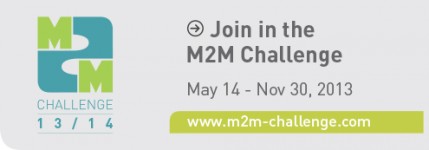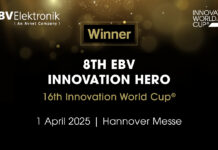The M2M Challenge, in its second year, is the leading m2m competition worldwide. Together with the title sponsors Swisscom and Ericsson and the sponsors Telit Wireless Solutions and VARTA Microbattery, as well as co-initiator m2mapps, the M2M Challenge is seeking cutting-edge energy applications among other categories, and will award the finalists with prizes worth over 160,000 USD.
Machine-To-Machine (M2M) is a broad term. M2M connections enable machines, vehicles and devices to communicate, to collect and share data through wired and wireless networks. Though because of this broad terminology M2M still is a sealed book for many consumers, but the Internet of Things (IoT) and M2M communications market is estimated to reach $290.0 billion by 2017 at a CAGR of 30.1% (MarketsandMarkets).
Energy is one of the sectors M2M has and will have a huge impact in. M2M communication can help produce sustainable energy consumption, and reduce greenhouse gas emissions. Utility companies, cities, businesses, and households can use this to lower their carbon footprint.
A Smart Grid offers utility companies a platform to better monitor, manage and control the electricity grid with a shorter deploy time and lower cost. It provides utilities with real-time data and facilitates efficient energy management. Companies can then adjust energy availability (gas and electricity) as well as pricing according to demand, like cutting down production and price at night, when demand for electricity drops.
Electric vehicles can be connected to a grid that monitors and controls energy usage; excess energy can then be fed back into the grid. Embedded sensor systems facilitate communication between a city and the grid. South Korea for example recently announced they will wirelessly charge their busses with specially equipped asphalt. A Smart City would make it a lot easier to find parking too – sensors could lead residents to the next free parking lot or spot by communicating with their smartphones.
Smart Homes and Smart Buildings efficiently use energy by managing electrical devices, heating, air conditioning etc.; turning power or heat on or off. Homeowners producing their own energy with renewable sources can store their excess energy for a later use. Smart Buildings monitor everything, from heating to elevators. Building managers can pull data, run analytics, fin-tune and optimize the energy performance of his building and are contacted in case of a power outage.
This is not only the future of the Internet of Things; we are already in the middle of it. Many great applications, gadgets and technologies are already out there, contestants of last year’s M2M Challenge would agree.
tado° for example who won the category “Energy” in 2012. Their intelligent heating control system works with a smartphone app to remotely turn the heating on, off, up or down. Or QGate who also won a category of the 2012 M2M Challenge. QGate looks like an ordinary power plug, but it connects living spaces with electrical devices and lets users monitor and control these through their smartphones.
For all this a reliable network and easy-to-integrate technologies are essential. These easy-to-integrate M2M technologies are what the M2M Challenge is looking for. Developers are invited to submit their ideas until November 30th 2013 at m2m-challenge.com. In addition to the category Energy, developers can submit their solution in the categories Energy, Mobility, Healthcare, Security and Consumer Electronics & More.







